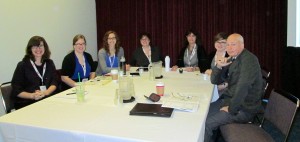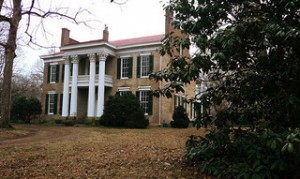"Sustaining Historic Preservation Through Community Engagement": A conversation continued
15 August 2014 – editors
preservation, advocacy, public engagement, community history, sense of place, government, funding, conference

Roundtable participants, from left to right: Ginna Foster Cannon, Rachel Boyle, Kim Connelly Hicks, Kristen Baldwin Deathridge, Eileen McMahon, Abigail Gautreau, and Theodore Karamanski. Photo credit: Kristen Baldwin Deathridge
At the 2014 annual National Council on Public History conference in Monterey, several of us came together for a roundtable discussion on “Sustaining Historic Preservation Through Community Engagement.” The roundtable was organized and facilitated by Theodore Karamanski from Loyola University and Kristen Baldwin Deathridge from Appalachian State University. We wanted to discuss the balance between community interests and economics in preservation. Connecting preservation to the conference theme Sustainable Public History, we asked: After the initial excitement has worn off in a preservation project, how does it remain relevant within a community?
Kristen opened by explaining what the group meant by sustainable historic preservation, arguing that true sustainability means preserving the historic built-environment for several generations. This involves looking at environmental and economic concerns as well as (sometimes) listing on the National Register of Historic Places. Beyond this, we need to be sure that the communities that live in and among our historic resources have real connections to the products we generate.
In the course of the discussion, several key themes emerged. Audience members asked about the most appropriate way to measure the impact of historic preservation on property values. One person suggested assessing property value by square footage because historic properties tend to be smaller. Another participant noted that assessment is tied to turnover and that ownership of historic properties may be more stable.
An audience member asked how to get new residents interested in the legacy of a historic community. Suggestions included hosting regular cultural events, like festivals, art shows, or even a summer camp to raise the local profile of historic sites.
Other audience members asked about measuring “soft” economic benefits in historic districts, like attracting tourists, how best to hand off a project, and why we are preserving places and for whom. Long-term commitment is necessary for sustainability, and this is also an ethical issue.

Historic Glen Leven, a farm that served as a Civil War field hospital, is one of the properties discussed by roundtable participants. Photo credit: Kelly Stewart
Regardless of all of the good work that preservationists and the National Trust of Historic Preservation have done, we must communicate in economic language. With many people still unaware of the positive impact of preservation, strong public relations emphasizing economic benefits remain key to sustainability.
It also remains important for the community to know the stories behind significant places. Even when a group has advocated for a project and brought in a preservationist, the professional isn’t usually there for the long term. This leads to the other key point raised: preservationists need to work with community members to meet the needs of that community. Neither of these ideas are new in preservation, but our discussions, both in Monterey and with the groups that we worked with, remind us just how important they are to keep in mind.
The responses from the audience also reflected diverse definitions of “sustainable” and different approaches to community engagement. The panelists offered examples from their own work that show how public historians are grappling with these questions in a variety of situations:
- In her research, Kristen Baldwin Deathridge evaluates how well adaptively reused religious buildings connect to the changing communities around them. She argues that for the long-term success of a preservation project, we need to consider what she calls the cultural success of a project. Religious buildings, for example, are often abandoned due to changes in the groups using them. Cultural success hinges on having enough community commitment to the historic environment that ongoing rescue attempts are not needed when changes take place.
- Next, Kim Connelly Hicks and Rachel Boyle, graduate students at Loyola University Chicago, presented their work on the National Register nomination for Chrysler Village, a district in Chicago’s South Side. Initiated by an energetic young alderman, the nomination aimed to elevate the profile of a neighborhood lacking adequate city services. Throughout the process, the project team sought community involvement through oral histories and community meetings in addition to engaging the neighborhood historical society and local media. As the nomination heads off to Washington, Rachel and Kim asked, “What’s next? How does the story of Chrysler Village’s historic development remain relevant to the current and future residents?”
- Ginna Foster Cannon, a PhD student at Middle Tennessee State University, then asked, “How does a preserved building develop roots in the community?” Ginna presented The Hermitage Hotel as an example of how this might be accomplished. The hotel has partnered with The Land Trust of Tennessee to donate a $3 surcharge per room per person directly to The Land Trust. Additionally, the hotel operates a garden at Glen Leven, a Land Trust property, connecting southern foodways and the legacy of Nashville farming.
- Abigail Gautreau, PhD candidate from MTSU, discussed the process for a Multiple Property Submission to the National Register for the civil rights movement in Selma, Alabama (1965-1972), which involved conducting community meetings to identify sites associated with the movement. These meetings revealed conflicting ideas about the Selma campaign. An oral history component of the nomination has evolved to become a repository for community memory and a space for alternative narratives. Abigail posed the question, “How does this project become their project without me here?”
- Eileen McMahon from Lewis University discussed an undergraduate history class project conducted for the National Trust of Historic Preservation. Historic preservation had been accused of forcing up property values around Lockport, Illinois. The NTHP requested that Eileen find a way to assess whether this was the case. The students analyzed the change in values between listed and non-listed properties over time and found no statistically significant difference in the value of properties in the historic district. However, during periods when considerable investment was made in preservation, historic properties themselves increased in value.
Clearly, there aren’t many one-size-fits-all solutions in preservation. We’ve raised several questions above, and few of those have easy answers. We believe that these are discussions worth having, and we’d like to continue the conversation here on the blog.
How would you answer some of the questions posed above? Please share examples of strategies for community engagement in your preservation efforts. How do these contribute to the sustainability of these resources? Have you been involved with any failed engagement efforts? What went wrong?
~ Kristen Baldwin Deathridge, assistant professor of public history and historic preservation at Appalachian State University; Kim Connelly Hicks, assistant curator at Kenilworth Historical Society; and Abigail Gautreau, PhD candidate in public history at Middle Tennessee State University.



